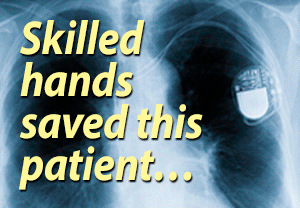 QRSD & Dyssynchony Optimization
QRSD & Dyssynchony Optimization
- by USMC-Pacer
- 2024-05-20 13:10:26
- Checkups & Settings
- 296 views
- 8 comments
Going to my device clinic where a specialist is going to optimize my QRS duration on the 28th. They noted on my recent ECHO - "Abnormal septal motion is present, consistent with the presence of left bundle branch block."
I interpret that as a septal flash and a clear indication of dyssynchony. All they told me is they want to narrow my QRSD as much as possible. From what I read, they are more than likely related. I have no idea what they are going to do as far as tests or settings.
Thoughts?
I'll keep ya'll posted :)
8 Comments
AgentX86
by USMC-Pacer - 2024-05-20 23:08:43
I think as usual you are on the money. I've read that septal flash can be related to AV and / VV delay programming beyond the default settings.
I'll report back with more info after the tune-up. Maybe we can all learn something :)
Yes please report back
by Gemita - 2024-05-21 05:01:59
USMC-Pacer, I am pleased you are getting some specialist help and I hope they are able to make real improvements with both your QRS duration difficulties and with synchronised pacing.
I know from your recent comments on another thread that you initially had a QRS duration of 198ms due to pacing induced cardiomyopathy. This improved to 127ms before increasing again to 150ms along with a slight decrease in your EF. You were told they needed to do some adjustments to the AV delay and VV delay to improve your condition. No doubt these will be the two areas that they will focus on? Perhaps they will put you on a treadmill to see what actually happens as your heart rate increases and falls.
You could ask about left ventricle upper rate interval (LVURI) lock‐in since I know you have been having some upper rate behaviour difficulties. This phenomenon can occur when the LVURI is programmed longer than the right ventricle upper rate interval (RVURI). I found out about this when I recently updated our FAQs. LVURI should usually be programmed shorter than the RVURI, and the difference should be sufficient in order to compensate for the interventricular delay, otherwise, it can lead to a form of desynchronization arrhythmia, which is characterized by RV pacing followed by a LV sensed event and loss of LV pacing. The arrhythmia can be initiated by a single loss of LV capture or by ventricular premature beats (VPB), and is then perpetuated (LVURI lock‐in) until a pause from a VPB or a decrease in the RV pacing rate can restore biventricular pacing.
I know you have had your aortic valve treated and perhaps your electrical disturbances are still ongoing and settling down from this and you may still need a little more time to improve following your intervention?
Like all electrical disturbances, bundle branch blocks can be intermittent. I have bundle branch blocks on occasions when PACs with aberrant conduction results in a wide QRS complex that may be confused with a ventricular ectopic beat. I can get PVCs too with retrograde conduction (backwards conduction). We all know that ectopic beats can adversely affect pacemaker timing and indeed make CRT less efficient, so you could ask about these issues as well. Perhaps they will adjust any meds you are taking too so that your CRT pacemaker will work better to provide synchronised, effective pacing, the higher the percentage of pacing, the better of course. Do you happen to know what your CRT percentage pacing is?
I shall be very interested to hear in detail what changes they make to your settings and why? How to effectively optimise CRT pacing is important to all of us should we need this intervention at some stage in the future. Good luck on the 28th and thank you so much for your post.
Gemita... LVURI & RVURI... and Pacing Percentage
by USMC-Pacer - 2024-05-21 10:19:13
Ut oh, you've given me more terms to go research, lol, and I have added them to my list for the EP.
It's strange that when I reach my UTR of 150, it doesn't stop there and will go higher as I stated before, but I definitely get a strange feeling like being in an elevator dropping fast :) ?? Perhaps, that is the result of dyssychrony? I dunno!
As far as CRT percentage, I am at 99.8% which is great. But, I'm not sure if that is just from atrium to ventricle? (AV)
I "think" the LBBB abnormal motion comes from the VV, resulting in the broadened QRSD, but honestly I have no idea.
I'm hoping the specialist knows her way around this and not just changing settings and experimenting. I agree, a treadmill test would be ideal.
Left Bundle Branch Block ( LBBB)
by Selwyn - 2024-05-22 14:20:04
I am not sure this isn't getting too complicated. A LBBB would always result in some asynchrony between the left venticular response and the right ventricular response as the left bundle supplies the septum and left ventricle.
In normal cardiac conduction, impulses travel equally down the left and right bundles, with the septum activated from left to right and the formation of small Q waves in lateral leads
In LBBB, conduction delay means that impulses travel first via the right bundle branch to the RV ( right ventricle) , and then to the LV ( left ventricle) via the septum
Septal activation is thus reversed eliminating lateral Q waves
The overall depolarisation vector from the right to left ventricle produces tall R waves in lateral leads (I, V5-6) and deep S waves in the right precordial leads (V1-3). The delay between activation of the RV and LV produces the characteristic “M-shaped” R wave seen in lateral leads
Delayed overall conduction time to the LV extends the QRS duration to ≥ 120 ms
That is, the septum ( does not depolarise on time from the normal left to right due to left BBB. The right ventricle is then likely to be prematurely contracting, compared to the normal later situation) as the left ventricular ( and left bundle ) is impaired.
Narrowing the timing of the pacemaker to aid the contraction of the septum/left ventricle makes sense as in LBBB it is delayed.
I hope this explains to you the septal motion problem and why the QRS duration shortening is likely to help using your pacemaker.
Elevator
by AgentX86 - 2024-05-22 15:14:42
The elevator dropping sounds like you've hit the upper tracking rate. To maintain AV shynchrony, the ventricles drop to a 2:1 block, meaning that your effectiveheart rate drops from 150 to 75. That's gotta suck. It'll stay there until the SI node gets back down, to well under 150. It's a mechanism to protect the ventricles from VT/Vfib.
The solution is to get your EP to increase your upper tracking rate. It might be set to 150 for a good reason, but often not. "If he complains, we'll think about it then." It may even be the out-of-the box default setting. You could look up the programming manual, if you're really interested.
All great responses!!!
by USMC-Pacer - 2024-05-28 09:02:05
Selwyn - your post explaines it nicely! Thanks!
AgentX86 - I'll ask about the UTR <-- I'm always complaining about that. The current difficulty they have with it is the defibrillator. For whatever reason 150bpm is the max while it is active. My EP has mentioned turning it off as my EF has increased a good amount. So, I'll wait for the results from these changes and go from there.
Thanks for all the responses..
Today is the day and I'll report back later!
Dyssynchrony
by islandgirl - 2024-05-31 00:34:38
I had to have resynchronization about every 6 months with a ICD-P. When it was time for a battery change, I was upgraded to a 3rd lead and it took care of the dyssynchrony.
Doing resynchronization, there was a cardio echo tech and my EP stood bedside at the interrogation computer. The EP would call numbers to the echo tech, and he would adjust settings on my device. It would take about an hour. Just like a long echo.........
You know you're wired when...
You read consumer reports before upgrading to a new model.
Member Quotes
Pacemakers are very reliable devices.


.png)


Dyssynchrony
by AgentX86 - 2024-05-20 14:18:37
Yes, sounds like a bit of RV/LV dyssynchrony. They'll likely change the timing between the RV and LV leads.
There is an "axis of rotation" that I don't fully understand. From what little I can gather, it's the, looking from the top, it's the direction the electrical signat propagates around the heart . The timing isn't just a straight line.
I could easily be all wet here. I really haven't studied it much. Here's a homework assignment for someone who wants to do a deep dive into the R/L dyssynchrony thing.